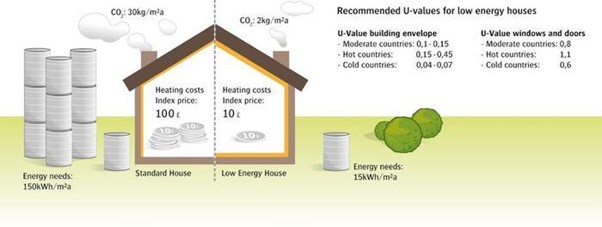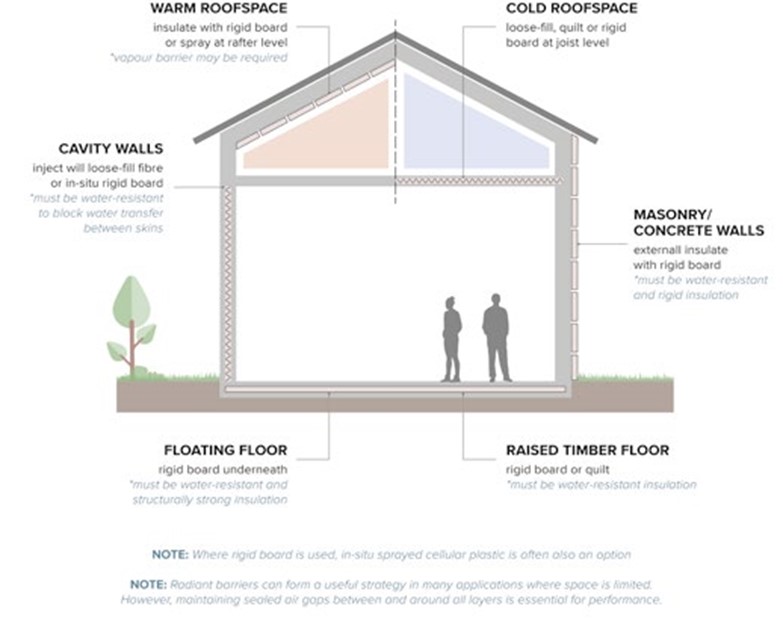Time to retrofit to secure a net zero future
Contents |
[edit] Introduction
If the UK is to have any chance of achieving its net zero carbon target by 2050, the existing building stock will have to be improved considerably with a comprehensive retrofit plan to improve thermal performance, reduce energy consumption and upgrade heating systems.
It is well known that Britain's housing stock is some of the oldest and poorest performing in Europe. With nearly six million houses built before 1919, the challenge before us is quite daunting as a good proportion of the UK's 29 million homes will need at least some improvement to reduce the 17% of total carbon emissions that comes from housing. [1]
[edit] Regulatory updates
Whilst higher standards for energy efficiency are being introduced for new build housing – the new and updated Part L of the Building Regulations for England came into force in June 2022, followed by new energy efficiency updates in Scotland and Wales in November and December 2022, and the Future Homes Standard for 2025 will require all new homes and other buildings to be built to ultra-high levels of energy efficiency, there is little to promote and deliver the improvements needed for existing buildings.
The government has a vague aim of upgrading existing homes to EPC C by 2035, but only where 'practical, affordable and cost effective'. This will require more than 15 million homes in England to be upgraded over the next twelve and a half years, but with no real strategy in place it is difficult to see how this can be achieved.
The Heat and Building Strategy published in 2021 expands on the detail of heat in buildings, but there is little on improving energy efficiency, reducing demand or the essential policy needed to support any large-scale approach to mass retrofitting.
If we are to move to a net zero carbon country by 2050 (2045 in Scotland), it will be vital to make improvements to homes and other buildings to reduce emissions. This means installing a whole range of energy saving measures; from better insulation and more efficient appliances, to replacing fossil fuelled boilers with low carbon alternatives such as heat pumps.
[edit] The role of insulation
The role of PIR and PUR insulation in upgrading our poorly performing housing stock and ensuring a sustainable future cannot be underplayed. Good insulation is essential and is one of the simplest and most cost-effective ways to reduce energy demand and cut CO2.
The lower the U-values in walls, floors and roofs, the less heat that is lost, resulting in enhanced thermal performance which in turn will help to deliver the standards required.
Highly effective and incredibly versatile, PIR and PUR insulation solutions are available in a range of forms including boards and blocks, cavity injected, composite panels, as well as spray and panel insulation. This with lambda values as low as 0.021 W/mK, PIR insulation performance can be achieved with less thickness than other commonly used insulation materials. Its exceptional insulating properties, high strength and light weight means it is used widely across residential, commercial and refurbishment projects.
Retrofitting insulation such as high-performance PIR is a valuable instrument in reducing heating demand, cutting CO2 emissions whilst addressing fuel poverty and improving comfort and wellbeing. Whether using internal or external insulation, it is vitally important the UK's housing stock is raised to an acceptable standard by making the fabric of the building as energy efficient as possible. Only then will we be able to provide a long-term asset that reduces energy usage and can be confidently passed on to future generations.
[1] Climate Change Committee’s Sixth Carbon Budget
This article first appeared in AT Journal issue 146 and was published on the CIAT website on 19 July 2023. It was written by the Insulation Manufacturers Association (IMA).
--CIAT
[edit] Related articles on Designing Buildings
Featured articles and news
UK Infrastructure: A 10 Year Strategy. In brief with reactions
With the National Infrastructure and Service Transformation Authority (NISTA).
Ebenezer Howard: inventor of the garden city. Book review.
The Grenfell Tower fire, eight years on
A time to pause and reflect as Dubai tower block fire reported just before anniversary.
Airtightness Topic Guide BSRIA TG 27/2025
Explaining the basics of airtightness, what it is, why it's important, when it's required and how it's carried out.
Construction contract awards hit lowest point of 2025
Plummeting for second consecutive month, intensifying concerns for housing and infrastructure goals.
Understanding Mental Health in the Built Environment 2025
Examining the state of mental health in construction, shedding light on levels of stress, anxiety and depression.
The benefits of engaging with insulation manufacturers
When considering ground floor constructions.
Lighting Industry endorses Blueprint for Electrification
The Lighting Industry Association fully supports the ECA Blueprint as a timely, urgent call to action.
BSRIA Sentinel Clerk of Works Training Case Study
Strengthening expertise to enhance service delivery with integrated cutting-edge industry knowledge.
Impact report from the Supply Chain Sustainability School
Free sustainability skills, training and support delivered to thousands of UK companies to help cut carbon.
The Building Safety Forum at the Installershow 2025
With speakers confirmed for 24 June as part of Building Safety Week.
The UK’s largest air pollution campaign.
Future Homes Standard, now includes solar, but what else?
Will the new standard, due to in the Autumn, go far enough in terms of performance ?
BSRIA Briefing: Cleaner Air, Better tomorrow
A look back at issues relating to inside and outside air quality, discussed during the BSRIA briefing in 2023.
Restoring Abbotsford's hothouse
Bringing the writer Walter Scott's garden to life.
Reflections on the spending review with CIAT.
Retired firefighter cycles world to raise Grenfell funds
Leaving on 14 June 2025 Stephen will raise money for youth and schools through the Grenfell Foundation.
Key points for construction at a glance with industry reactions.


























